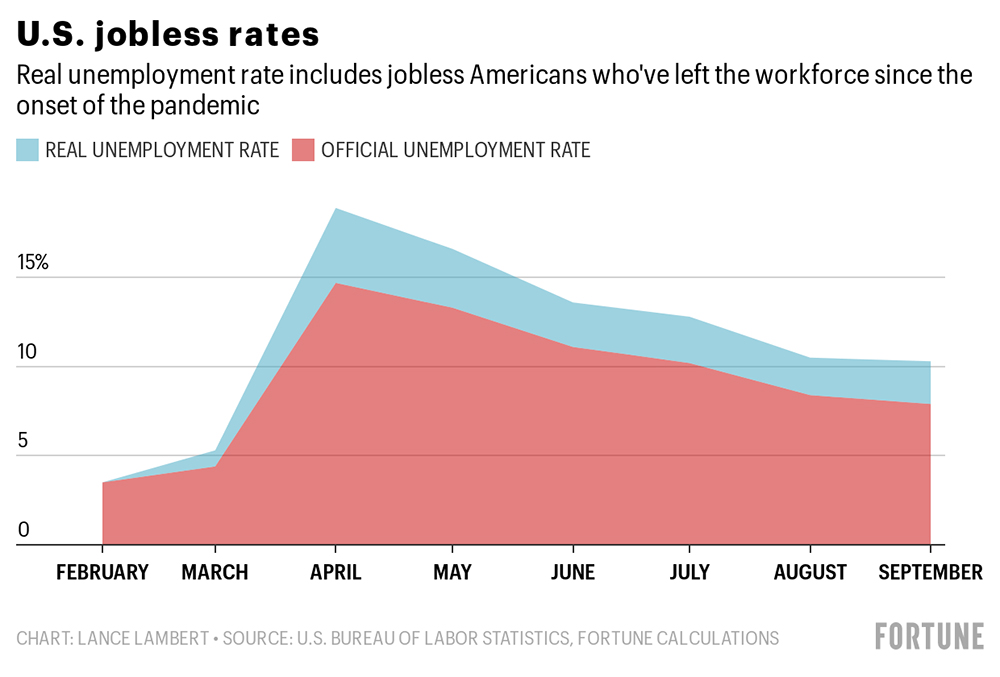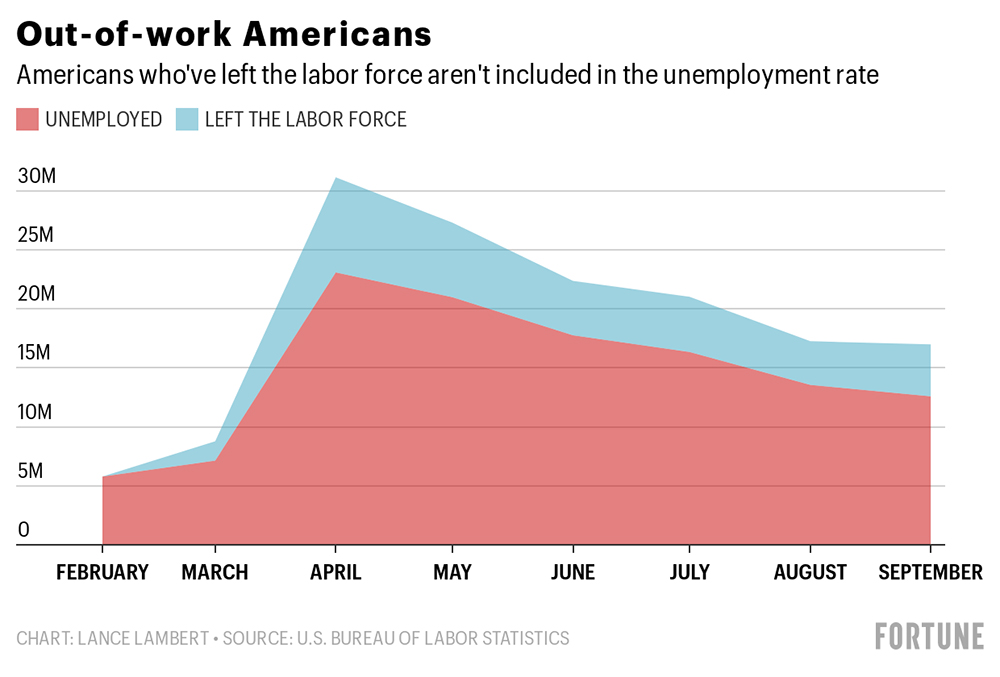在今年4月疫情封鎖措施最嚴(yán)格的時(shí)候,,美國的失業(yè)率達(dá)到14.7%,,是1940年以來的最高水平。但隨著各州紛紛解封,,失業(yè)率快速下降,。9月的失業(yè)率再次下降,從8.4%降至7.9%,。
雖然失業(yè)率持續(xù)下降意味著經(jīng)濟(jì)正在從衰退向增長轉(zhuǎn)變,,但美國對失業(yè)人數(shù)的統(tǒng)計(jì)可能存在嚴(yán)重不足。
根源在于美國勞工統(tǒng)計(jì)局(Bureau of Labor Statistics)計(jì)算官方失業(yè)率的方式:只有正在尋找新工作的失業(yè)美國人才會(huì)被歸入失業(yè)人口,。如果失業(yè)者沒有在找工作,,他們就會(huì)被排除在勞動(dòng)力人口以外。(以美國失業(yè)人口數(shù)量除以勞動(dòng)力人口得出失業(yè)率,。)
在疫情期間一直是這樣的情況,。有數(shù)以百萬計(jì)的美國失業(yè)者選擇等到疫情結(jié)束和居家隔離令取消之后再去找工作。最近的數(shù)據(jù)還顯示有許多女性離開了勞動(dòng)力隊(duì)伍,,出現(xiàn)這種趨勢的原因可能是許多學(xué)校還沒有復(fù)課,,或者采取了混合授課的方式?!敦?cái)富》雜志的《The Broadsheet》專欄統(tǒng)計(jì),,在上個(gè)月的110萬失業(yè)者中,有80%是女性,。美國的勞動(dòng)力人口從2月的1.645億減少到4月的1.565億,。雖然后來恢復(fù)到1.601億,,但依舊比2月減少了440萬人。

在計(jì)算失業(yè)率時(shí),如果將尚未重回勞動(dòng)力隊(duì)伍的440萬美國失業(yè)人口包含在內(nèi),,可以得出《財(cái)富》雜志所說的“實(shí)際”失業(yè)率,。據(jù)《財(cái)富》雜志計(jì)算,9月的實(shí)際失業(yè)率為10.3%,。這一數(shù)字遠(yuǎn)高于勞工統(tǒng)計(jì)局計(jì)算的官方失業(yè)率7.9%,。
實(shí)際失業(yè)率也在下降:4月的實(shí)際失業(yè)率達(dá)到最高點(diǎn)18.9%,當(dāng)時(shí)的官方失業(yè)率為14.7%,。但實(shí)際失業(yè)率依舊是較高的兩位數(shù),,這表明經(jīng)濟(jì)完全復(fù)蘇還有很長的路要走:2月的實(shí)際失業(yè)率和官方失業(yè)率均為3.5%。

在經(jīng)濟(jì)衰退期間,也有美國失業(yè)者離開了勞動(dòng)力隊(duì)伍,,但遠(yuǎn)沒有本次疫情期間這么嚴(yán)重,。2009年10月,失業(yè)率達(dá)到大衰退時(shí)期的最高點(diǎn)10%,。與此同時(shí),,按照《財(cái)富》雜志的計(jì)算,實(shí)際失業(yè)率為10.6%,。2009年10月的勞動(dòng)人口較前一年減少了約110萬人,,而2020年9月減少了440萬人。(財(cái)富中文網(wǎng))
翻譯:劉進(jìn)龍
審校:汪皓
在今年4月疫情封鎖措施最嚴(yán)格的時(shí)候,,美國的失業(yè)率達(dá)到14.7%,,是1940年以來的最高水平。但隨著各州紛紛解封,,失業(yè)率快速下降,。9月的失業(yè)率再次下降,從8.4%降至7.9%,。
雖然失業(yè)率持續(xù)下降意味著經(jīng)濟(jì)正在從衰退向增長轉(zhuǎn)變,,但美國對失業(yè)人數(shù)的統(tǒng)計(jì)可能存在嚴(yán)重不足。
根源在于美國勞工統(tǒng)計(jì)局(Bureau of Labor Statistics)計(jì)算官方失業(yè)率的方式:只有正在尋找新工作的失業(yè)美國人才會(huì)被歸入失業(yè)人口,。如果失業(yè)者沒有在找工作,,他們就會(huì)被排除在勞動(dòng)力人口以外。(以美國失業(yè)人口數(shù)量除以勞動(dòng)力人口得出失業(yè)率,。)
在疫情期間一直是這樣的情況,。有數(shù)以百萬計(jì)的美國失業(yè)者選擇等到疫情結(jié)束和居家隔離令取消之后再去找工作,。最近的數(shù)據(jù)還顯示有許多女性離開了勞動(dòng)力隊(duì)伍,出現(xiàn)這種趨勢的原因可能是許多學(xué)校還沒有復(fù)課,,或者采取了混合授課的方式,。《財(cái)富》雜志的《The Broadsheet》專欄統(tǒng)計(jì),,在上個(gè)月的110萬失業(yè)者中,,有80%是女性。美國的勞動(dòng)力人口從2月的1.645億減少到4月的1.565億,。雖然后來恢復(fù)到1.601億,,但依舊比2月減少了440萬人。
在計(jì)算失業(yè)率時(shí),,如果將尚未重回勞動(dòng)力隊(duì)伍的440萬美國失業(yè)人口包含在內(nèi),,可以得出《財(cái)富》雜志所說的“實(shí)際”失業(yè)率。據(jù)《財(cái)富》雜志計(jì)算,,9月的實(shí)際失業(yè)率為10.3%,。這一數(shù)字遠(yuǎn)高于勞工統(tǒng)計(jì)局計(jì)算的官方失業(yè)率7.9%。
實(shí)際失業(yè)率也在下降:4月的實(shí)際失業(yè)率達(dá)到最高點(diǎn)18.9%,,當(dāng)時(shí)的官方失業(yè)率為14.7%,。但實(shí)際失業(yè)率依舊是較高的兩位數(shù),這表明經(jīng)濟(jì)完全復(fù)蘇還有很長的路要走:2月的實(shí)際失業(yè)率和官方失業(yè)率均為3.5%,。
在經(jīng)濟(jì)衰退期間,,也有美國失業(yè)者離開了勞動(dòng)力隊(duì)伍,但遠(yuǎn)沒有本次疫情期間這么嚴(yán)重,。2009年10月,,失業(yè)率達(dá)到大衰退時(shí)期的最高點(diǎn)10%。與此同時(shí),,按照《財(cái)富》雜志的計(jì)算,,實(shí)際失業(yè)率為10.6%。2009年10月的勞動(dòng)人口較前一年減少了約110萬人,,而2020年9月減少了440萬人,。(財(cái)富中文網(wǎng))
翻譯:劉進(jìn)龍
審校:汪皓
At the height of lockdowns the unemployment rate reached 14.7% in April, its highest level since 1940. But as states eased those restrictions, the rate quickly fell. It dropped again in September, falling from 8.4% to 7.9%.
While that sustained drop signals an economy moving from recession to growth, it's also severely undercounting joblessness.
It boils down to how the Bureau of Labor Statistics (BLS) calculates the official unemployment rate: Only out-of-work Americans who are searching for new positions are categorized as unemployed. If the jobless aren't searching, they get thrown out of the civilian labor force altogether. (The unemployment rate is calculated by dividing the number of unemployedAmericans by the civilian labor force count).
That's been the case during the pandemic, with millions of jobless Americans choosing to wait out the virus and stay-at-home order before starting their job search. Recent numbers also show a stunning number of women have recently left the workforce, a trend that is likely tied to the fact that many schools have not resumed in-person learning or have implemented hybrid schedules. According to Fortune's The Broadsheet newsletter, 80% of the 1.1 million workers who dropped out of the workforce last month were women. Overall the civilian labor force declined from 164.5 million in February to 156.5 million in April. It has since climbed up to 160.1 million—but it's still down 4.4 million.
If the 4.4 million jobless Americans who've yet to return to the workforce were to be included in the unemployment rate—what Fortune considers the "real" unemployment rate—it would sit at 10.3% in September, Fortunecalculates. That's well above the 7.9% official unemployment rate calculated by the BLS.
The real unemployment rate is falling too: It peaked at 18.9% in April, when the official unemployment rate was at 14.7%. But a real unemployment rate still sitting above double digits underscores that we have a long way to go for a full recovery: Both the real and official unemployment rates sat at 3.5% in February.
Jobless Americans often leave the workforce during deep recessions—but nothing on the level we've seen during the pandemic. The unemployment rate peaked at 10% in October 2009 during the Great Recession era. At the same time the real unemployment was 10.6%, according to Fortune's calculations. The October 2009 labor force was down about 1.1 million from the year prior—compared to the 4.4 million in September 2020.






